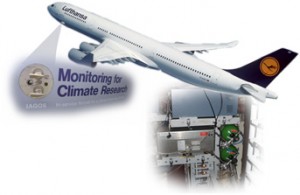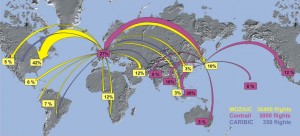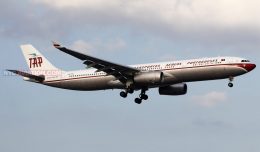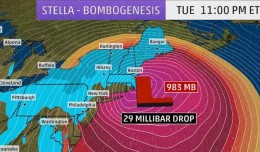We’ve talked a lot about the weather lately here at NYCAviation, how it impacts airline operations and how the airlines counter those effects. At times Mother Nature’s fury can put airlines on their heels, reacting to the potential knockout blows of severe thunderstorms in the summer and ice storms and blizzards in the winter. The delays and cancellations associated with severe weather cost the US airline industry billions annually, not to mention inconveniencing millions of passengers. That said, modern technology is allowing the airline industry to use airliners to collect atmospheric data that leads to more accurate forecasts in the short term and better assessments of climate change for long term climate models.
The first use of commercial airliners to take air samples of the upper troposphere and lower stratosphere (otherwise known as the tropopause region) during routine commercial flights occurred in the 1970’s. NASA’s Global Atmospheric Sampling Program (GASP) used 747s from Pan Am, United and Qantas, as well as NASA’s own CV-990 testbed, equipped with automatic air sampling equipment to measure ozone, carbon monoxide (CO), water vapor, cloud particles and condensation nuclei. The objectives of the program were to gain an understanding of the dynamics of the atmosphere where airliners flew as well as to develop atmospheric models to assess potential adverse effects from aircraft emissions.
 The European Commission funded a similar program using Airbus aircraft. In 1994 the MOZAIC (Measurement of OZone and water vapor by Airbus Inservice airCraft) program took flight on an Air France A340 operating between Caracas and Bogota. Like GASP, MOZAIC utilized a number of A340 aircraft with specially designed measuring devices stored in the equipment bay taking air samples during routinely scheduled international flights. Over the course of the program, thousands of flights collected comprehensive data on the levels of ozone, water vapor, carbon monoxide and nitrogen in the earth’s atmosphere. The data collected in the tropopause was a great supplement to the ground and satellite-based systems also used to collect atmospheric information. This data has helped scientists to refine existing climate models and improve weather forecasting models. It has also been used to build up the only database worldwide of water vapor and ozone measurements. While GASP focused primarily on the effect aircraft had on the environment, MOZAIC was more focused on climate change as whole, observing the level of greenhouse gasses, aerosols and cloud particles present in this layer of the atmosphere to determine the current state of air quality and how that could impact future climate change.
The European Commission funded a similar program using Airbus aircraft. In 1994 the MOZAIC (Measurement of OZone and water vapor by Airbus Inservice airCraft) program took flight on an Air France A340 operating between Caracas and Bogota. Like GASP, MOZAIC utilized a number of A340 aircraft with specially designed measuring devices stored in the equipment bay taking air samples during routinely scheduled international flights. Over the course of the program, thousands of flights collected comprehensive data on the levels of ozone, water vapor, carbon monoxide and nitrogen in the earth’s atmosphere. The data collected in the tropopause was a great supplement to the ground and satellite-based systems also used to collect atmospheric information. This data has helped scientists to refine existing climate models and improve weather forecasting models. It has also been used to build up the only database worldwide of water vapor and ozone measurements. While GASP focused primarily on the effect aircraft had on the environment, MOZAIC was more focused on climate change as whole, observing the level of greenhouse gasses, aerosols and cloud particles present in this layer of the atmosphere to determine the current state of air quality and how that could impact future climate change.
MOZAIC was followed up years later by IAGOS (Inservice Aircraft for A Global Observing System), a program that also uses Airbus airliners operating long-range international flights. IAGOS features redesigned monitoring equipment which adds less weight to the aircraft. Lufthansa kicked off the program in 2011 with an A340. Currently there are six A340’s and one A330 participating in the program, which is supported by a number of airlines including Lufthansa, Air France, Cathay Pacific, Iberia, China Airlines and Air Namibia. It is hoped that the program could be expanded to include up to 20 aircraft operating across the globe to continue contributing vital atmospheric data to the scientific community. Other programs, such as CARIBIC and Contrail have employed airliners to collect air quality samples as well.
In addition to collecting data to study climate change, airliners are also contributing to daily weather forecasts and in many cases using that information to their own benefit. Southwest Airlines has 87 of its 737s equipped with water vapor sensing equipment that provides moisture data gathered at high altitude to the airline’s operations center, as well as to the National Weather Service (NWS). While the NWS has plenty of ground-based weather sensors, their airborne data collection systems are limited to weather balloons that are launched twice a day. This means the NWS airborne data could be up to 12 hours old, and the balloon launch locations are limited, so the data may been collected hundreds of miles away.
Aircraft collecting data while traversing their regular routes help to fill in the gaps in forecast data. An example of this occurred last November when a storm bringing freezing rain and ice was forecast for the Dallas area. As has become customary, airlines cancelled hundreds of flights to and from Dallas in advance to mitigate the risk of getting aircraft and crews caught up in the storm. Southwest’s sensor equipped aircraft revealed that atmospheric conditions were actually too warm, and in some places actually dry, to produce any freezing precipitation thus allowing the airline to maintain its schedule intact. Airborne moisture rates also help to provide up to the minute forecasts of developing weather fronts, allowing airlines better advance knowledge of potential trouble spots their flights should avoid.
UPS has also outfitted 25 of its aircraft with similar devices. Other U.S. airlines like American, United and Delta have installed sensors in their aircraft that relay turbulence information to the ground, helping dispatchers alert other pilots of rough air in advance. This has helped the airlines reduce maintenance costs, injury risks and of course increase passenger comfort.
While only 1 percent of the commercial airline fleet are equipped with moisture sensors, they are providing valuable atmospheric data to the NWS and there are calls for expanding their use. Changes in climate patterns have a large impact on not only the airline industry, but also on life in general. The more data at meteorologist’s disposal, the better prepared we can all be for future weather events.
Gabe Andino is an Associate Editor for NYCAviation.com, aviation enthusiast and airport management professional residing in New Jersey. Follow him on Twitter @OGAndino.








